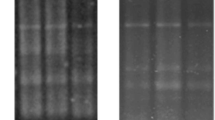Abstract
Several phosphate solubilizing microorganisms (PSM) were tested for their efficiency at 35°, 40° and 45°C. There was a marked variation in their ability to solubilise tricalcium phosphate and the effect was more pronounced at 45°C. Two bacterial and one fungal strain were found to be thermotolerant as they solubilised a large amount of tricalcium phosphate at the three tested temperatures. These thermotolerant strains were identified as Bacillus subtilis (TT0), Bacillus circulans (TT8) and Aspergillus niger (TT10). Seed inoculation of mung bean showed a better establishment of temperature tolerant strains as revealed by the rhizosphere population. The inoculation improved nodulation, the available P2O5 content of the alluvial soil, root and shoot biomass, straw and grain yield and phosphorus and nitrogen uptake of the crop. Among the bacterial strains, the best effect on yield was obtained with B. subtilis. However, statistically it was equivalent to streptomycin resistant mutant (M-20) and Pseudomonas striata (27). A. niger was less effective than bacteria. Though superphosphate was found to be a better source of phosphate fertiliser, the use of rock phosphate (RP40), coupled with phosphate solubilising bacteria (PSB), gave results comparable to superphosphate (SP20) + PSB inoculants.
Similar content being viewed by others
References
Alexander M 1983 Introduction to Soil Microbiology, 3rd Edition, 465 p.
BareaJ M, NavarroE and MontoyaE 1976 Production of plant growth regulators by rhizosphere phosphate solubilising bacteria. J. Appl. Bacteriol. 40, 128–134.
BopaiahB M 1985 Occurrence of phosphate solubilising microorganisms in the root region of Areconut Palm. J. Plantation Crops. 13, 60–62.
CochranW G and CoxG M 1957 Experimental Designs, 2nd Edition, John Wiley and Sons, Inc. New York.
CravenP A and HayasakaS 1982 Inorganic phosphate solubilisation by rhizosphere bacteria in Zostera marina Community. Can. J. Microbiol. 28, 605–610.
Gaind S 1987 Studies on Thermotolerant Phosphate Solubilising Microorganisms Ph.D. thesis, P.G. School, IARI, New Delhi-12.
Gaur A C 1972 Role of phosphate solubilising microorganisms and organic matter in soil productivity. Symp. Soil Productivity. Nat. Acad. Sci. India. pp 259–268.
GaurA C and GaindS 1983 Microbial solubilisation of insoluble phosphates with particular reference to iron and aluminium phosphate. Sci. Cult. 48, 110–112.
GaurA C, MadanM and OstwalK P 1973 Solubilisation of phosphatic compounds by native microflora of rock phosphate. Ind. J. Exptl. Biol. 11, 427–429.
GaurA C, OstwalK P and MathurR S 1980 Save superphosphate by using phosphate solubilising cultures and rock phosphate. Kheti 32, 23–25.
JacksonM L 1967 Soil Chemical Analysis. Prentice Hall of India Pvt. Ltd., New Delhi.
Kanwar J S and Grewal J S 1974 Phosphorus fixation in Indian soils. A review. ICAR technical bulletin No. 29. 44 p.
KunduB S and GaurA C 1980c Establishment of nitrogen fixing and phosphate solubilising bacteria in rhizosphere and their effect on yield and nutrient uptake of wheat crop. Plant and Soil 57, 223–230.
KhalafallahM A, SeberM S M and Abdel-MaksoudH K 1982 Influence of phosphate dissolving bacteria on the efficiency of super phosphate in a calcareous soil cultivated with Vicia faba Z. Pflanzenernaehr. Bodenkd. 145, 455–459.
MahmoudS A Z, Abdel HafexA M, El-SecyM and HanefyE A 1973 Inorganic phospate dissolving bacteria in the soils of Egypt and rhizosphere of broad bean and wheat. Agrokem Talajtan 22, 351–356.
Olsen S R, Cole C V, Watanable F S and Dean L A 1954. Estimation of available phosphorus in soil by extraction with NaHCO3. USDA circular No. 939.
Pelczer Jr M J, Chan E C S and Kreig N R 1986. Microbiology 5th Ed. 917 p.
PikovskayaR E 1948 Mobilisation of phosphorus in soil in connection with vital activity of some microbial species. Mikrobiologiya 17, 362–370.
SardinaM G, SolardeJ L and ErtolaR J 1986 Solubilisation of phosphorus from low grade minerals by microbial action. Biotechnology 8, 247–252.
SattarM A and GaurA C 1987 Production of auxins and gibberrellins by phosphate dissolving microorganisms. Abl. Mikrobiol. 142, 393–395.
SinghH P, PareekR P and SinghT A 1984 Solubilisation of rock phosphate by phosphate solubilisers in broth. Curr. Sci. 53, 1212–1213.
VancuraV 1964 Root exudates of plants. Plant and Soil 21, 231–248.
VancuraV and HarizlikovaA 1972 Root exudates of plants. Plant and Soil 36, 271–282.
Author information
Authors and Affiliations
Rights and permissions
About this article
Cite this article
Gaind, S., Gaur, A.C. Thermotolerant phosphate solubilizing microorganisms and their interaction with mung bean. Plant Soil 133, 141–149 (1991). https://doi.org/10.1007/BF00011908
Received:
Issue Date:
DOI: https://doi.org/10.1007/BF00011908




